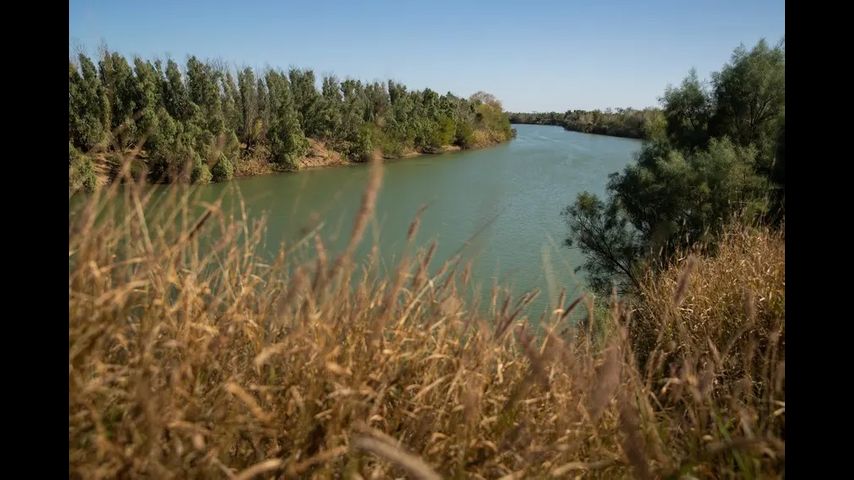Mexico is offering water to South Texas. But there’s a catch farmers aren’t happy about.
Subscribe to The Y’all — a weekly dispatch about the people, places and policies defining Texas, produced by Texas Tribune journalists living in communities across the state.
McALLEN — Rio Grande Valley farmers who have seen their industry devastated by insufficient rain and depleting water reserves have been offered up a modest but helpful amount of water for their dried-up land.
The farmers are hesitating to accept it.
Farmers and the irrigation districts that supply water to farmers remain in a stalemate with the Texas Commission on Environmental Quality over 120,000 acre-feet of water that Mexico offered up to the U.S.
This is the catch: If the farmers accept the water now, they will have to give up the water they already own and need for next year.
In mid-October, farmers and irrigation districts met with representatives from TCEQ and the International Boundary and Water Commission, the federal agency that oversees water treaties between the U.S. and Mexico, to discuss the offer.
It entails more than 120,000 acre-feet of water that Mexico offered up to the U.S. after heavy rains caused significant runoff from Mexico's Marte Gomez reservoir, which is at 123.7% capacity.
If IBWC accepted the water and allocated it to Texas, TCEQ would be responsible for distributing the water within the state through their watermaster program based on who owned the rights to water.
Many water rights holders don't have sufficient water for the planting season in the spring, said Sonny Hinojosa, a water advocate with the Hidalgo County Irrigation District No. 2. If TCEQ were to charge them for accepting the water being offered by Mexico now, the water they already own and which they intended to preserve for the next planting cycle, would be released for other uses.
"A farmer's not going to invest in seed and prepping the land if he doesn't see enough water stored behind the dam to finish out his crop," Hinojosa said. "It's too big of an investment."
TCEQ told farmers and employees of irrigation districts who were present that not charging them for that water would be unfair to other water rights holders who don't receive the San Juan river water, according to Hinojosa, who hopes to convince the department that everyone would benefit.
If they're not charged and their current water is maintained in the reservoirs, that water could be reallocated to others if enough water comes in later from rain or other sources.
"The water that we don't ask to be released for us stays behind the dam, and when there's the next allocation, everyone gets a piece of the pie," he said.
The Falcon and Amistad reservoirs supply water to farmers and irrigation districts in the Rio Grande Valley, but levels there remain low from a lack of sufficient rainfall to meet farmers' needs.
The U.S. side of the reservoirs is also supposed to receive water from Mexico under the terms of a 1944 treaty. Mexico must deliver 1,750,000 million acre-feet of water to the U.S. from six tributaries every five years, or an average of 350,000 every year. But Mexico has fallen behind, with a balance of more than 1.3 million acre-feet it needs to deliver by the October 2025 deadline.
The San Juan River is not one of those six tributaries, but if that water is accepted, it would be credited towards Mexico's water debt.
Reaching an agreement on the offered water soon is important as that water is in danger of spilling over the dam.
"There is a danger if they get rain in this region and the water starts to spill," said Maria-Elena Giner, IBWC commissioner. "The other thing is that if we don't start using some of that water, or that commitment isn't made very soon, others in Mexico may say, well, then we'll keep it, and we'll use it for our users."
It's that urgency that motivated Texas Agriculture Commissioner Sid Miller to issue an executive order last week authorizing farmers and irrigation districts to use water from the Rio Grande.
"Every day is critical," Miller said, adding that TCEQ's hands were tied on the matter. "By the time they got through the bureaucratic red tape, I was afraid the water's already out the gulf."
But Miller’s authority to give farmers that access is questionable at best. TCEQ said water rights were governed by the Texas Water Code and TCEQ regulations.
"All Texans along the Rio Grande should continue to comply with these requirements," a spokesperson for TCEQ wrote in an email.
The department added it continued to work with local stakeholders and the IBWC on negotiating water deliveries from Mexico.
The IBWC said they appreciated Miller’s efforts to help South Texas producers and irrigation districts. Giner said the agency continues to urge Mexico to provide a plan to address the shortfall and make good on their water deliveries.
Reporting in the Rio Grande Valley is supported in part by the Methodist Healthcare Ministries of South Texas, Inc.
This article originally appeared in The Texas Tribune at https://www.texastribune.org/2024/10/25/texas-mexico-water-rio-grande-valley/.
The Texas Tribune is a member-supported, nonpartisan newsroom informing and engaging Texans on state politics and policy. Learn more at texastribune.org.





